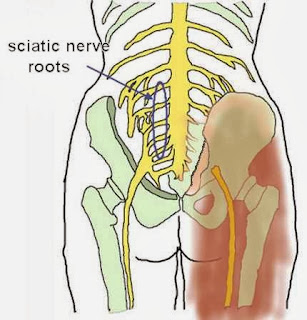Detail Guide of Sciatica Pain
All those who have experienced sciatica pain know how painful and excruciating it can be. Until now many people believe that sciatica is a disease, but it is a symptom. It results from problems that are associated with the sciatic nerve, such as inflammation, compression and injury near it.
Very challenging
when
dealing
with
extreme
sciatica pain.
The impact will make simple activities such as getting dressed, going to the
bathroom, and standing will be difficult to do. Every part of a person's life
will be affected when having extreme sciatica pain. Another
effect
is
that you never seem to
get enough
sleep
because
of a shift in
position
can
cause
considerable pain to awaken.
Driving becomes difficult because
sciatica nerve pain may prevent full control over the clutch, gas and brake
pedals. That same pain also interrupts concentration, making it hard to work.
Sciatica Pain Symptoms
- There
is a constant pain coming down one side from the lower back, through the thigh
and down the leg.
- The pain becomes worse while
sitting.
- Difficulty moving the leg coupled
with numbing.
- Flashes of acute pain
- The pain is caused by pressure on the nerve that can take place in different parts along one of the two sciatic nerves. The symptom of the specific pain will also depend on where this pressure is taking place which is why sciatic pain can be felt in the lower back, or the leg. Similarly that pressure along the sciatic nerve will cause the different symptoms (while sitting, through the back and into the leg, flashes of pain or the leg movement difficulties).
- The majority of sciatica pain attacks are usually over in a short period of time, from a few days to one or two weeks and tend to disappear on their own. Though the episode is of short duration, pain relief is needed. If it is a one-off event and gets better on its own you will soon forget about it. However if the pain is recurrent it is always advisable to visit a specialist as this could be an indication that you should take preventive measures to avoid a worsening of the situation. The type of therapy that will generally be advised is based on guided exercise and pain management.
- There are cases where the severity
of the pain is such that you need a more aggressive solution or when the pain
does not diminish on its own. For these cases a structured program involving
physical therapy will be needed and in more acute and severe cases there is the
possibility of needing a surgical intervention.
The Pain of Sciatica Causes
Piriformis syndrome
is
the most
common
cause
of sciatica
pain.
Piriformis Syndrome occurs when the
piriformis muscle, due to tightness or spasms, pinched or compressed the sciatic
nerve.The piriformis muscle starts in the lower spine, it crosses the buttocks,
and connects to the thigh bone, if this muscle becomes inflamed and swollen it
will pinch or put pressure on the nerve causing the sciatica pain. This is
because the nerve runs underneath the muscle so, when the muscle swells it
places pressure on the nerve which causes the pain you feel in your lower back,
buttocks, and legs.
Sciatica might create pain and
discomfort, weakness, even lack of feeling along the sciatic nerve's pathway.
Moreover, it's accompanied by low lower back pain and afflicts every individual
at some time and to some extent. Again and again, this perplexing problem
causes lower back pain that can occur unexpectedly and can go on for an
extended time. For this and several other reasons, when back pain sufferers
ignore sciatica pain, they are ignoring a issue that may turn into a life-long
battle. Though the causes for sciatica pain are abundant, it should not be
assumed that it is just an aggravated muscle. Infections, ruptured discs,
internal bleeding, and causes which are more serious aren't uncommon. Suffering
through the pain will not make it go away.
Sciatica Pain Treatment
- Muscle relaxers - these can also help in relaxing the muscles
associated with your sciatica and relieving the pain.
- Physical therapy - physical therapy is also recommended for people
with sciatica pain.
- Exercise - people who suffer from sciatica may prefer to lie in
bed so they don't experience any pain, but a sedentary lifestyle can actually
worsen the sciatic nerve pain you're feeling. Exercise is usually recommended
for those with sciatica since this can help build your buttocks and leg muscles
to prevent further injury to your sciatic nerve.
There are also other treatments
available for those suffering from sciatica if the conventional treatment
options do not work. So do not give up and lose hope if you've tried these
things but keep looking for another treatment if the sciatica pain has not
healed. There are many resources out there that can give you help for sciatica.

No comments:
Post a Comment